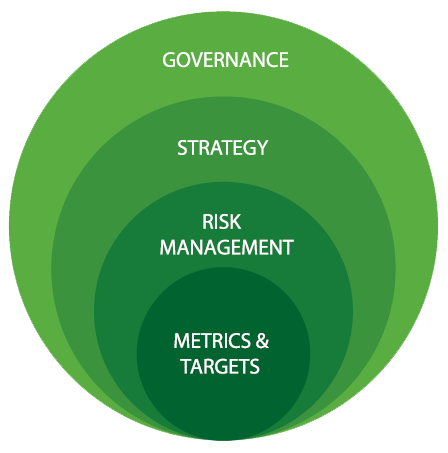Integrating Sustainability across the Business
At Dabur, we recognise that long-term value creation hinges on a strong, forward-looking approach to sustainability and risk management. Our approach is structured around four key pillars — Governance, Strategy, Risk Management, and Metrics & Targets. This together enable us to identify risks, harness opportunities, and deliver long-term value for all stakeholders. The following framework illustrates how these interconnected elements guide our decision-making and strengthen our resilience in a dynamic business environment.

Growing Responsibility Living Sustainably

At Dabur, we believe that doing good is not just a responsibility , it’s a way of life. Our ESG journey is rooted in this belief, shaping how we grow, source, and serve. In FY 2024-25, we advanced our ESG agenda by integrating sustainability into core decision-making, guided by robust board oversight, ethical conduct, and transparent reporting.
We’ve taken meaningful steps to embed sustainability into every decision we make — from protecting biodiversity and supporting farmers, to reducing our carbon footprint and strengthening governance. These aren’t just metrics on a dashboard; they’re reflections of our values, our people, and our promise to future generations.
OUR ESG GOALS & TARGETS
Climate and Biodiversity
- Net Zero Emissions by FY 2045 (in alignment with SBTi commitment).
- 100% elimination of coal usage across operations by FY 2025.
- No Net Loss to Biodiversity by FY 2050.
- 100% operations outside protected and ecosensitive zones.
- 100% mitigation of risks associated with critically endangered species (Gugal, Aconite, etc.) by FY 2026.
Sustainable Sourcing
- No Gross Deforestation in the supply chain and in our own business operations by FY 2045.
- 100% sustainable sourcing of high deforestation risk materials by FY 2026.
Circular Economy
- 80% reusable, recyclable, or compostable packaging by FY 2028.
- To maintain plastic waste positive status every year.
- Use 30%, 10%, and 5% of recycled plastic packaging content in plastic packaging of non-food grade items for Category I, Category II, and Category III plastics, respectively, by FY 2026.
Energy & Water
- Achieve >60% energy from renewable and cleaner sources in the total energy mix by FY 2026.
- Reduce Water Intensity in operations by 30% by FY 2026 from the baseline.
- Reduce energy intensity by 30% FY 2026 from the baseline.
- Achieve water positivity in our operations and communities.
Diversity
- Achieve 21% gender diversity at the managerial level by FY 2028.
Social Impact
- To positively impact and transform the lives of 5 million individuals by FY 2030 through social interventions focused on creating empowered and self-reliant communities.
- Sustainably cultivate medicinal & aromatic plants across 15,000 acres by FY 2030.
- Enhance the livelihood of more than 13,500 farmers’ families by FY 2030 (100% increase over 2020).
Note: In FY 2024-25, we conducted a double materiality assessment. Based on the outcomes of this assessment, we are in the process of revisiting our ESG goals and targets to ensure stronger alignment with material issues and stakeholder interests.
OUR ESG PERFORMANCE
Climate and Biodiversity
- Sustained the achievement of ‘zero coal-based emissions’ in operations.
- 100% of DIL’s own operations are outside protective and eco-sensitive zones.
- Achieved 100% mitigation of risk associated with critically endangered herbs through cultivation measures in the reporting year.
Sustainable Sourcing
- 93.4% sustainable sourcing of high deforestation risk materials in the reporting year.
Circular Economy
- 87% recyclable packaging consumption in the reporting year.
- Maintained plastic positivity status in the reporting year.
- In the reporting year, use of recycled plastics in ‘Category l’ is 4%, ‘Category ll’ is 3% and ‘Category lll’ is 0%.
Energy & Water
- 61% of the total energy consumed in operations is from renewable sources in the reporting year.
- In the reporting year, we achieved a 30% reduction in water intensity (KL/MT) from the baseline.
- In the reporting year, we achieved a 12% reduction in energy intensity1 (GJ/MT) from the baseline.
- Water conservation capacity within the fence (factories) enhanced to 2,47,589 KL and water conservation capacity beyond the fence (communities) enhanced to 9,44,697 KL, marking a 353% increase over the previous year.
Diversity
- 13.4% gender diversity at the managerial level in the reporting year.
Social Impact
- Positively impacted the lives of 3.61 million people during the reporting year through CSR interventions focused on creating empowered and self-reliant communities.
- Sustainably cultivated medicinal and aromatic plants on 13,191 acres of land.
- Engaged 12,753 farmers in the cultivation of herbs and 17,141 individuals in beekeeping, enhancing their livelihoods.
Governance
- Appointment of lead independent director in May 2023.
- 100% independent audit committee.
- 90.4% board meeting attendance.
- 89.1% average attendance of all board-level committee meetings.
Over the past few years and in the reporting year we have taken several initiatives to transition from non-renewable energy sources to renewable energy sources. This is in alignment with our science-based Net Zero commitment. This transition has led to more than 60% of renewable energy and, in parallel, a 27% reduction in absolute Scope 1 emissions from the 2021 baseline year of the energy intensity target. Though the transition to renewable energy in operations (coal / other non-renewable fuels to biomass) has led to emission reduction, it has limited our performance in the energy intensity reduction.

